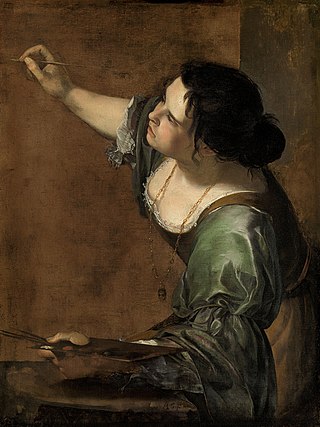
Artemisia Lomi or Artemisia Gentileschi was an Italian Baroque painter. Gentileschi is considered among the most accomplished seventeenth-century artists, initially working in the style of Caravaggio. She was producing professional work by the age of 15. In an era when women had few opportunities to pursue artistic training or work as professional artists, Gentileschi was the first woman to become a member of the Accademia di Arte del Disegno in Florence and she had an international clientele.
Katherine Porter (1941) is an American artist. Born in Cedar Rapids, Iowa in 1941, Porter is considered one of the most important contemporary artists associated with Maine. She resists categorization. Through the medium of painting and drawing her visually stunning canvases convey the conflict inherent in life. She expresses her ideas with a visual vocabulary that is "geometric and gestural, abstract and figurative, decorative and raw, lyric and muscular."
Dana Frankfort is an artist based in Houston and a painting professor at University of Houston. Her work often engages with the history of abstract art and features bright colors, gestural brushwork, and text.

Esther Geller was an American painter mainly associated with the abstract expressionist movement in Boston in the 1940s and 1950s. She was one of the foremost authorities on encaustic painting techniques.
Susanna J. Coffey is an American artist and educator. She is the F. H. Sellers Professor in Painting at the School of the Art Institute of Chicago and lives and works in New York City. She was elected a member the National Academy of Design in 1999.

Susan Schwalb is a contemporary silverpoint artist.

Howardena Pindell is an American artist, curator and educator. She is known as a painter and mixed media artist, her work explores texture, color, structures, and the process of making art; it is often political, addressing the intersecting issues of racism, feminism, violence, slavery, and exploitation. She is known for the wide variety of techniques and materials used in her artwork; she has created abstract paintings, collages, "video drawings," and "process art."
John Lees is an American contemporary expressionist artist who works primarily in painting.
Aaron Fink is an artist working in a variety of mediums including oil, prints, sculpture and works on paper.
Boston Expressionism is an arts movement marked by emotional directness, dark humor, social and spiritual themes, and a tendency toward figuration strong enough that Boston Figurative Expressionism is sometimes used as an alternate term to distinguish it from abstract expressionism, with which it overlapped.

Barbara Swan (1922–2003), also known by her married name, Barbara Swan Fink, was an American painter, illustrator, and lithographer. Her early work is associated with the Boston Expressionist school; later she became known for her still-life paintings in which light is refracted through glass and water, and for her portraits. She is also known for her collaboration with the poets Anne Sexton and Maxine Kumin, and for her archived correspondence with various artists and writers.

Peri Schwartz was an American painter and printmaker. Her work is held in major museums worldwide.
Robert Feintuch is an American painter who lives and works in New York City.
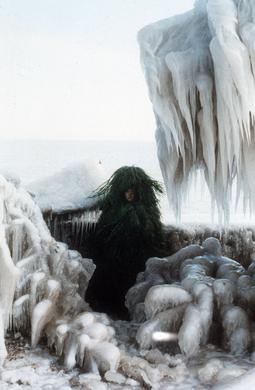
Fern Shaffer is an American painter, performance artist, lecturer and environmental advocate. Her work arose in conjunction with an emerging Ecofeminism movement that brought together environmentalism, feminist values and spirituality to address shared concern for the Earth and all forms of life. She first gained widespread recognition for a four-part, shamanistic performance cycle, created in collaboration with photographer Othello Anderson in 1985. Writer and critic Suzi Gablik praised their work for its rejection of the technocratic, rationalizing mindset of modernity, in favor of communion with magic, the mysterious and primordial, and the soul. Gablik featured Shaffer's Winter Solstice (1985) as the cover art for her influential book, The Reenchantment of Art, and wrote that the ritual opened "a lost sense of oneness with nature and an acute awareness of ecosystem" that offered "a possible basis for reharmonizing our out-of-balance relationship with nature."
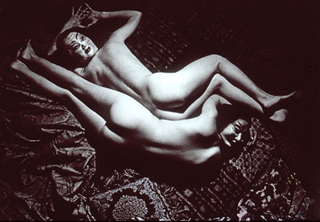
Carole Harmel is an American artist and photographer, who gained recognition for her provocative images of nudes in the 1970s and 1980s and still lifes combining photography with short narratives, wordplay and mixed media. Fundamental to Harmel's work is a questioning of reality and photographic conventions, a penchant for surrealism, and humor. The New Art Examiner described her nudes as having a "startling, queasy impact," "rich in ambiguity, discomforting in content." About her still lifes, critic Michael Weinstein wrote, "sophisticated academic criticism is fused with love of color and visual form to create images at once conceptually engaging and perceptually arresting."

John Dilg is an American painter based in the Midwest. He is known for idiosyncratic landscapes that use a pared-down visual vocabulary drawing on imagination, vernacular artifacts, folk art and art historical sources. Critics describe them as dreamlike ruminations on place, the fragility of nature, the collective unconscious and mystical storytelling. Precedents for his work that have been cited include 19th-century Romantic landscape painters, Marsden Hartley, Georgia O’Keeffe and Horace Pippin, and the imaginary vistas of Henri Rousseau.
Jackie Saccoccio was an American abstract painter. Her works, considered examples of gestural abstraction, featured bright color, large canvases, and deliberately introduced randomness.
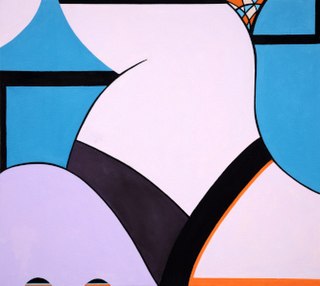
Amanda Church is an American artist known for abstract paintings that reference the human figure and other discernible elements. Her works straddle representational and formalist art traditions, suggesting recognizable body parts, objects, and perspectival elements in an otherwise abstract field. Church's distinctive use of contrasting style elements has been consistently noted by critics such as Hyperallergic's Cora Fisher, who described Church's work as "whimsically overruling the left-right brain dichotomy as well as the traditionally gendered axis that divides geometric and decorative art." Church received a Guggenheim Fellowship in 2015 and a Pollock-Krasner Foundation grant in 2017, among other awards. Her work has been covered in publications such as The New York Times, The Boston Globe, ARTnews, Hyperallergic and Forbes Magazine. Her paintings have been exhibited in major U.S. cities as well as internationally, in galleries and museums such as the Brooklyn Museum of Art and the Aldrich Museum. She lives and works in New York.
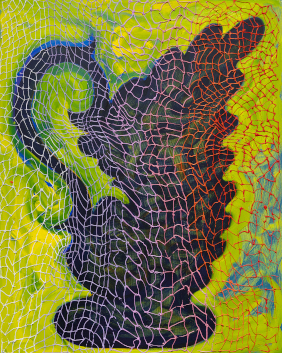
Wendy Edwards is an American artist known for vibrant, tactile paintings rooted in organic forms and landscape, which have ranged from representation and figuration to free-form abstraction. Her work has been strongly influenced by the 1970s Pattern and Decoration movement and its embrace of ornamentation, repetition, edge-to-edge composition, sensuality and a feminist vision grounded in women's life experience. Critics note in Edwards's paintings an emphasis on surfaces and the materiality of paint, a rhythmic use of linear or geometric elements, and an intuitive orientation toward action, response and immediacy rather than premeditation. In a 2020 review, Boston Globe critic Cate McQuaid wrote, "Edwards's pieces are exuberant, edgy, and thoughtful … [her] sweet, tart colors and delicious textures make the senses a gateway into larger notions about women and men, creation and mortality."

Colleen Randall is an American abstract painter and art educator. Her work is rooted in the abstract expressionist and sublime traditions and the relationship between nature and human consciousness. Art historian Sarah G. Powers has written, "Like seasonal and climatic shifts, Randall's work responds to nature and weather patterns through materiality and form. As meditations on the impact of sublime natural forces, her paintings transport us from the material fact of painted marks on a surface to a rich and rewarding imaginative experience." Randall has exhibited at the National Academy of Design and The Painting Center in New York, the Hood Museum of Art, and Delaware Art Museum, among other venues. She lives and works in West Lebanon, New Hampshire with her husband, poet and professor Jeff Friedman, and teaches at Dartmouth College.
















